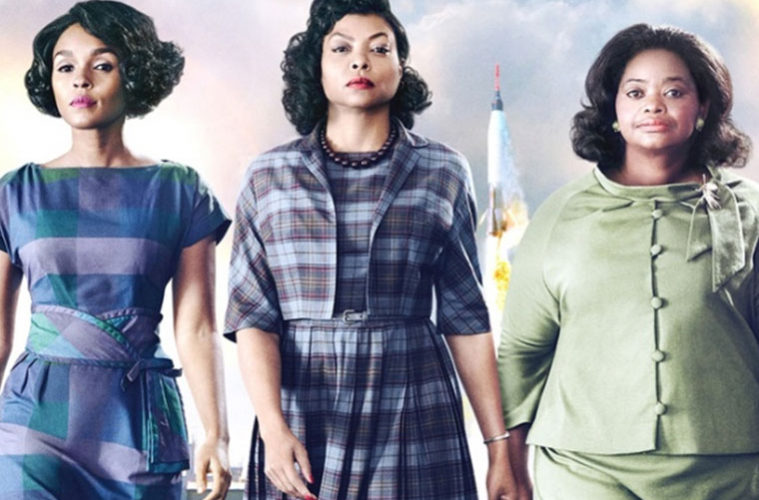Written by James Jones
Film Review: Hidden Figures
Rating: 4/5
Unsurprisingly, the #OscarsSoWhite controversy from last year’s award ceremony has had a significant impact within Hollywood. The Oscars’ shocking lack of diversity appears to have been redressed somewhat this year, and leading this is Hidden Figures which has been nominated for several awards, including Best Picture.
Hidden Figures tells the little-known story of the African-American women who worked at NASA during the 1960s as “computers” – that is, undertaking all the complex calculations which helped to put the first American into space. In a working environment dominated by men, being a woman at NASA was a tough job, let alone being a black woman having to struggle with not only intricate mathematics and sexism, but also deeply-embedded racism. The film follows the stories of three real-life geniuses: Katherine Johnson (who is still alive today at 98, and played by Taraji P. Henson), Dorothy Vaughn (Octavia Spencer) and Mary Jackson (played by Janelle Monáe). All the characters proved to be pioneers in their respective careers and, although each is given a sketch of a backstory outside their working lives, it is Katherine Johnson who is the centre of the film.
Katherine Johnson, it is no exaggeration to say, was fundamental to John Glenn becoming the first American to orbit the Earth, dealing with very difficult maths in an age when computers had about as much power as Tamagotchi. A successful Russian launch of a man into space increases the pressure on NASA to follow suit, and Katherine is moved to the Space Task Group to help with their work, under the supervision of Al Harrison, played engagingly by Kevin Costner. Meanwhile, Dorothy Vaughn is trying for promotion to supervisor level – a role she already does but for which she is not recognised – and Mary Jackson is attempting to become NASA’s first female engineer.
These individual stories have a common thread in the shape of race relations and American civil rights, and the science and broader issues of equality are nicely intertwined in the script. Although some scenes do sacrifice believability for theatricality (a barnstorming monologue by Katherine decrying the fact that her white male colleagues refuse to use the same coffee pot as her is pleasing to watch but rather unrealistic), the general message of women doing it for themselves and the slow movement towards racial equality in the US is a feel-good one.
There are plenty of comedic moments throughout, and the performances are impressive across the board. Octavia Spencer, perhaps best-known for her work in the equally moving race-relations story The Help, shines with warmth and humour, as does Janelle Monáe, taking her fight to become a NASA engineer all the way to the courts. The experiences of these three women are all underscored and shaped by the staggering levels of inequality: a motif in the film sees Katherine having to run halfway across the NASA campus to use toilets designated for black employees, as there are none in her new Space Task Group offices. The forty minute round-trip doesn’t go unnoticed by Kevin Costner’s character, who literally smashes down the “colored bathroom” sign before observing “Here at NASA, we all pee the same colour”. Although his actions are motivated by a desire for productivity, rather than any concerns for civil rights, the moment is still a rousing one.
One can’t help thinking that more than a touch of artistic licence has been exercised here, but the warmth of the film as a whole does a lot to soften the less believable moments. The casual (and, often, highly intentional) racism on display in Hidden Figures is most apparent in the character of Paul Stafford (played by The Big Bang Theory’s Jim Parsons), a colleague of Katherine’s with a refusal to believe that a woman (let alone a black woman) could out-perform him on the number-crunching front. Kirsten Dunst, too, plays a woman imbued with a degree of prejudice that she wishes to ignore: a powerful encounter with Dorothy Vaughn in the now unsegregated ladies toilet does much to dispel that impression. The discrimination experienced by the three central characters may, at times, seem to have been written into the screenplay for dramatic effect. Unhappily, however, it is probably a wholly-accurate portrayal of what black men and women suffered in even the most elevated of jobs in 1960s America.
Hidden Figures combines themes of science, complex maths, race, and sexism into an engaging and likeable film. It is, perhaps, a little unsubtle and superficial at times, but the characters (and their real-life counterparts) tell a story of importance and triumph, without ever losing sight of what makes a good film. Assured direction from Theodore Melfi, combined with a screenplay which balances wit with message, creates a film which is deserving of its Oscar nominations. It does more than merely put to bed the demons of #OscarsSoWhite.





